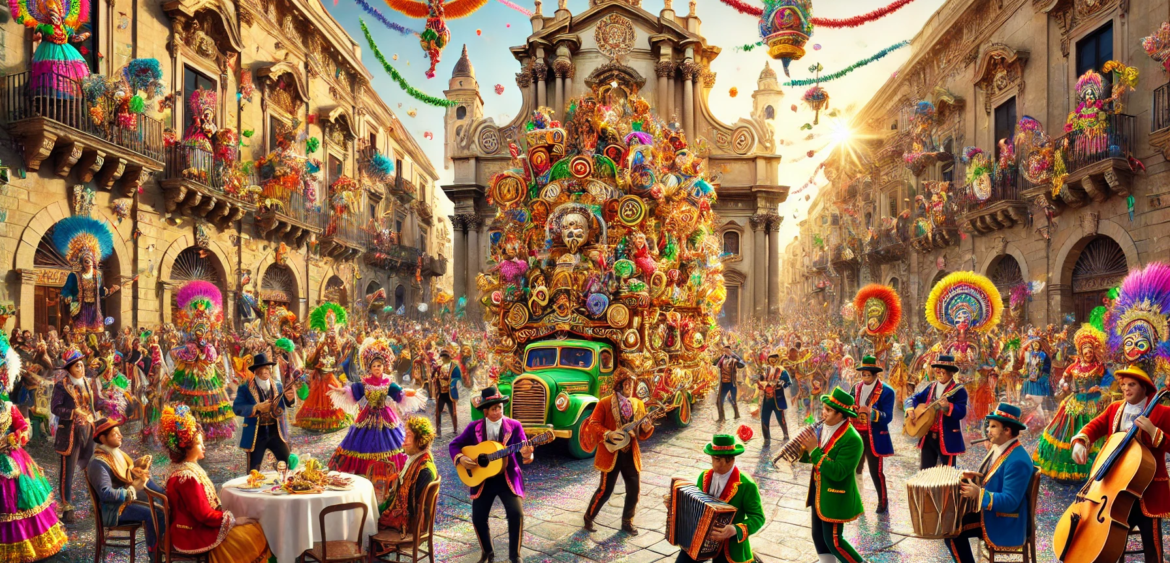 Sicily DMC: Carnival in Sicily
Sicily DMC: Carnival in Sicily
As in many other parts of the world, means happiness. Masks, confetti and streamers are everywhere together with a lot of music. Almost every town organizes something for carnival. But where is the best carnival in Sicily ?
There are many towns which assert that they have the best or the oldest carnival in Sicily. However, three towns celebrate carnival wiht special events. They are Acireale, near Catania, also famous for its baroque architecture, Sciacca, near Agrigento, famous for its thermal baths and Termini Imerese, another town famous for thermal baths, near Palermo.
 The Carnival in Sicily has ancient origins. It is the feast of abundance and binge eating before Lent fasting. This is the week of the year when delicious gravies and rich dishes are served at our tables; macaroni, cavateddi (a type of pasta) with meat sauce and pork rind, the traditional fat Thursday soup, typical of Modica County, and a lot of sweets as the Turkish’s heads of Scicli, the pignolata of Messina and the delicious chiacchere, strips of sweet pastry dough fried and coated with powdered sugar.
The Carnival in Sicily has ancient origins. It is the feast of abundance and binge eating before Lent fasting. This is the week of the year when delicious gravies and rich dishes are served at our tables; macaroni, cavateddi (a type of pasta) with meat sauce and pork rind, the traditional fat Thursday soup, typical of Modica County, and a lot of sweets as the Turkish’s heads of Scicli, the pignolata of Messina and the delicious chiacchere, strips of sweet pastry dough fried and coated with powdered sugar.
ACIREALE: It is considered one of Sicily’s most beautiful carnivals: the Carnival of Acireale, magnificent Baroque city in the Province of Catania.
Acireale’s Carnival boasts an almost-ancient tradition, having begun in the 16th Century – and since, having run every February from then on as a spontaneous party among the people.
Peculiar to this fest was the launching of rotten eggs and citrus fruits in streets – at least until an edict finally banned this “game.” At the start of the 1700s, the Carnival took on more refined tones thanks to a new addition: “abbatazzi” or folk poets that improvised rhymes on the streets of Acireale.
In the 19th Century, the “cassariata” then came on the scene, the parade of distinguished, horse-led carriages from which nobles launched sprays of candy and confetti at spectators. Yet it was only in the 1930s that papier-mache masks entered into the picture, along with floats led by steers and accompanied by various characters and satirical groups in constant movement.
Making the Carnival of Acireale even more spectacular are the parades of ebullient and outrageous floats, a draw for thousands of tourists every February. So beloved is the Carnival of Acireale that the act is repeated in August: taking advantage of the beautiful summer nights, the City puts on the Parade of the Grotesque Floats.
The merits of visiting Sicily and above all the splendid City of Acireale get bumped up even higher when you consider that not far off exist a range of breathtaking sites to visit. Think Catania, Mt. Etna, and the deep blue sea lying in wait on all sides of this amazing isle.
SCIACCA: The Carnival of Sciacca (Agrigento) has very old origins and it seems to be linked to the ancient, Roman Saturnalia. The floats figures are majestic and the masked groups’ movements are very graceful and attractive.
Artisans of papier-mache, architects, illustrators, blacksmiths, choreographers and dancers work for months and months with great alacrity and mastery. Unpublished poems in Sicilian dialect are recited by spontaneous poets whose satire is inspired by the local and national political personalities.
The Grotesque floats and masked groups parade along the streets of the historical center starting from fat Thursday, when the key of the city is symbolically given to the king of Carnival, Peppi ‘Nappa, untill fat Tuesday, when the King’s Float is burnt at the stake.
TERMINI IMERESE: In Termini Imerese (Palermo) the parades of the Grotesque Floats satirize the personalities from the worlds of politics and entertainment. Very characteristic are the puppets of the nannu and the nanna, (the grandparents) whose tradition dates back to the 800, imported by the Neapolitans who came with the Borbones escaping from Naples.
The nannu represents the Carnival which is burnt at the stake on Fat Tuesday, marking the end of the period of the joy. The Nanna, on the other hand, is a thin and tall woman symbolizing the pain and the penitence of the Lent. One of the most amusing moments of the party is the reading of the nannu’s will, through which the most important personalities of the city are teased.
Also check out our highlights:








